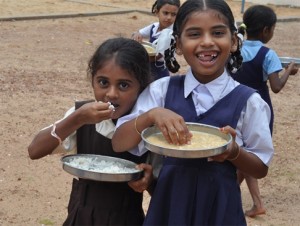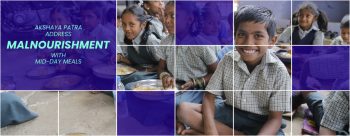What is the meaning of education? Why is it necessary that every child below 14 years of age go to school and get educated? How would this impact the child’s life? If a child goes to school then who will help out with work? This is probably the thought process of a parent from a marginalised background when you tell her/him that their children rather go to school than work in the fields.
Though this is 2014, many regions and communities in India are of the opinion that education is not as important as making two ends meet. This is mainly because their exposure to the importance of education is not sufficient. Organisations like The Akshaya Patra Foundation play the role of a catalyst and carry this message to such remote regions in the form of mid-day meals to be distributed to school children. Through these initiatives, and provisions like the Right To Education (RTE) Act, the Government of India has made constant efforts to tackle issues of malnutrition and illiteracy.
In order to support and incentivise education, the Supreme Court of India, in the year 2001, directed all State Governments to introduce cooked mid-day meals in primary schools. Philanthropists and non-profits like The Akshaya Patra Foundation have ever since adopted the Government mid-day meal scheme and implemented it in thousands of schools across India. But despite these efforts, reaching out to a large portion of the population from vulnerable backgrounds remains a challenge. Various factors like social and economic barriers obstruct the transmission of such awareness to these strata of the society. It is very difficult to break these age-old barriers built over centuries, and transcend the message across.
In the year 2002, The Constitution of India included Article 21-A that mandated free and compulsory education to all children in the age group of 6 to 14 years as a Fundamental Right. Furthermore, the Right of Children to Free and Compulsory Education (RTE) Act, 2009, under Article 21-A, states that every child has a right to full time elementary education of satisfactory and equitable quality in a formal school which satisfies certain essential norms and standards.
 However, there is enough proof that the efforts of the Government combined with those of philanthropic groups, backed by major social reformation initiatives can change the face of literacy and nutrition in rural areas.
However, there is enough proof that the efforts of the Government combined with those of philanthropic groups, backed by major social reformation initiatives can change the face of literacy and nutrition in rural areas.
During one of the visits to an Akshaya Patra beneficiary school in Adugodi, Bangalore, we witnessed an incident. A young girl in civilian clothes walked into the school principal’s office with a box of sweets. On enquiring further, we were told that the girl is a former student of the same school. She was here to share the news about her getting a job and to thank her teachers for imparting education to her. The girl was about 18 years old. She had accomplished her Pre-University education and was recruited by a bank for a clerical position.
Narrating a similar incident, Raffath Unnisa, a senior teacher in another Bangalore-based government school said, “There was this boy I taught in school years ago. He was highly interested in studies and was good at it also. But one day he didn’t show up at school and missed many consecutive days after that. On investigating the matter, we found that the child’s grandmother wouldn’t let him study. Since he was the only male child in the family, she preferred that he work in the fields with his parents than attend school.”
The dedicated teacher then approached his parents and explained to them how important it was for their son to study. It took her a few more visits to convince them to send him back to school. “Today he is all grown up and works for the Income Tax department,” exclaimed Unnisa with pride. These incidents validated the fact that the efforts of non-profits like Akshaya Patra yield noteworthy results only because of complete support from the Government.

Government schools across India have various resources and facilities for children like qualified teachers, hygiene and sanitation, safe drinking water, mid-day meals, spacious play areas, libraries, computer and science laboratories, school uniforms and so on. One of the ways to reach out to the remaining children (especially girls) in our country who are not attending school yet, is by improving facilities like sanitation and hygiene. Another important method to address the school enrolment and attendance issue is creating awareness in economically underserved communities about the gravity of education. The more people understand the seriousness behind education, the better will it serve the future of India.







